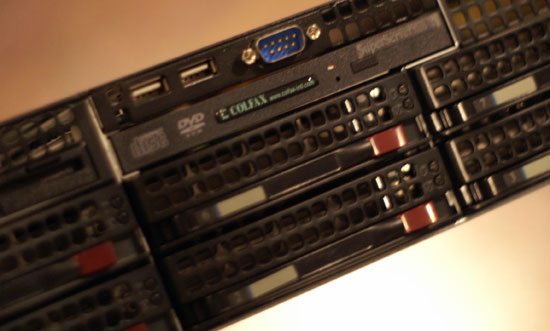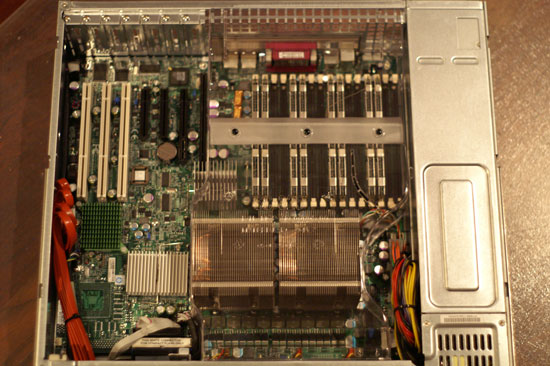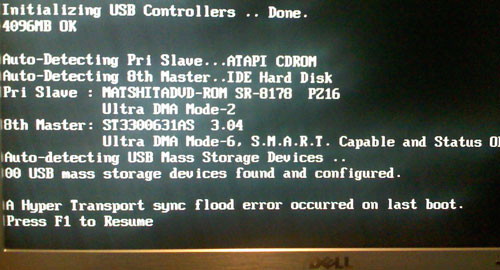AMD Phenom Preview: Barcelona Desktop Benchmarks
by Anand Lal Shimpi on September 10, 2007 12:03 AM EST- Posted in
- CPUs
The Servers
AMD was kind enough to send us two servers, identically configured, from Colfax. The configurations were as follows:
| AMD | Intel | |
| Motherboard | Supermicro H8DMU+ | Supermicro X7DBE+ |
| BIOS Revision | DMU8157v3.ROM | R1.3C |
| CPU | 2 x Opteron 2350 (2.0GHz) | 2 x Xeon 5345 (2.3GHz) |
| Memory | 8GB (8 x 1GB DDR2-667) | 8GB (8 x 1GB FBDIMM-667) |
| Hard Disk | 1 x Seagate Barracuda ES (400GB) | 1 x Seagate Barracuda ES (400GB) |
| Power Supply | 700W Redundant | 700W Redundant |
| OS | Windows Server 2003 SP1, 64-bit | Windows Server 2003 SP1, 64-bit |
These are standard Socket-1207 servers, meaning they don't take advantage of the split power-planes of Barcelona. Newer motherboards (such as the one Johan used in his tests) will support split power-planes, allowing Barcelona to run its North Bridge at a higher clock frequency, thus improving memory performance. Note that our desktop benchmarks were run under Windows Vista Ultimate (32-bit). Update: AMD has confirmed that these motherboards are Socket-1207+ and thus support split power-planes. We apologize for the error.

2U Colfax server

Colfax Intel Server

Colfax AMD Server, one CPU removed
Both systems worked just fine, but we did spend more time with the AMD system (obviously). During our testing we'd occasionally get a Hyper Transport error upon reboot, but it was intermittent and didn't interfere with our results:

Then, at the very end (literally two hours before publication) of our benchmarking, the AMD server stopped POSTing. As of now the system will simply sit there and spin its fans without actually putting anything on the screen. A number of things could have happened, but thankfully the Barcelona system decided to die after we ran all of our tests.
The take away point here is that AMD is working as quickly as possible to push out this Barcelona release. While AMD states to expect availability as early as today, we're concerned about the maturity of these platforms. We got our test systems on Friday, if this were truly a large, widespread launch we would've had hardware long ago. Whereas everyone and their mom already has a sample of Intel's 45nm CPUs, Barcelona continues to be tough to come by and performance hasn't been anywhere near final until now.
Logistics aside, we now have final silicon in hand (and a dead server on our floor), so let's see what we can do.










70 Comments
View All Comments
kevinkga - Friday, November 23, 2007 - link
Interesting review but it looks like you've given the system to gamers to test. These systems seem to be built for server-class systems, where performance for stuff like encoding, gaming etc is not relevant. Instead, why not:1. Have a gentoo install done and bechmark against that? CFLAGS tweaking and stuff would truely reveal where this processor thrives or fails.
2. Why not use a process intensive application or thread intensive application such as apache under loads of stress or a highly threaded application server such as websphere? In these cases latency on communication between processes or threads running on different cores is much more important than GHz performance. AMD uses hypertransport between its processor, one of the things that its got an edge comapared to intel. IPC or interthread communication for server-class benchmarks make much more sense that normal multimedia benchmarks that are used for desktops.... c'mon guys.
spinportal - Wednesday, September 19, 2007 - link
So what is the going talk on Phenom vs. Peryn?Phenom launch is when? Late 2007? bad news
Peryn launch is Nov 12th. Wolfdale is dual/Yorkfield is quad (without interconnects).
Phenom is called PhenomX4 for quad-core? and PhenomX2 for dual-core?
Will Phenom support multi-cpu motherboards or is that just Opt/Barcelona?
Will Peryn support multi-cpu mobos or is that just Xeon/Harpertown?
What we need is a metric for the 2.33 or 2.5 GHz releases for Phenom & Peryn .
What is the comparison of a Athlon X2 6000+ to a Phenom X2 2 GHz in performance and price?
Wolfdale vs. Conroe (175$US) @ 2.33 GHz ~ +5%
PhenomX2 vs. K8 X2 3800+ (65$US) @ 2.0 GHz ~ +15%
Conroe @ 2.66 Ghz (320$US) vs. K8 X2 6000+ (165$US) @ 3.0 Ghz ~ +18%
(+24% vs. X2 4400+)
Now for the pulling numbers out of a hat:
Wolfdale @ 2.33 GHz vs. PhenomX2 @ 2.33 GHz ~ +14%
Street Worth: 200$US vs. 100$US
But you know AMD will need to price higher to protect its AM2 line, and Intel will put its price premium in as to not deflate Conroe.
Est Retail: 240$US vs. 180$US
cocoviper - Tuesday, September 11, 2007 - link
In light of Barcelona's "close but no cigar" performance I really think AMD should use a strategy from their own playbook from Spring/Summer of 99. K7 was looking to be a pretty good performer, but it wasn't quite there yet so AMD respun the K6-2 and K6-III's as the K6-2+ and K6-III+ (0.18 micron versions). These things were drop in replacements that were ultra cheap (both to produce and to buy), ran cool, overclocked really well and brought needed cash into AMD until they were able to stabilize the K7 and move to the Thunderbird.I say continue pushing hard to get Barcelona north of 3GHz, but in the mean time, have some people respin a either a cut down K8 derivitive to 65nm or a standard K8 to 45nm (only if 45nm will be up and running before Feb to March) and push it out as quick as possible. Then they can make some cash in the mainstream market from alot of inexpensive CPUs.
coolme - Friday, September 14, 2007 - link
Good idea, AMD can actually be the first cpu manufacturer to sell new x86 processors in the < $100 range. With new shrinked K8s and cheap cheap single-core Barcelona. (less cache, no power improvements, and possibly off-die memory controller to aviod low yields, but cheap cheap cheap)Visual - Wednesday, September 12, 2007 - link
even a simple return of the 939 x2s would give them quite a lot of sales, i think.i personally would not hesitate to buy even a 6200+ x2 if they made it available and as cheap as the am2 versions now.
also that will in no way replace my future purchase of a quadcore k10 (or two, in a 4x4 board) so they shouldn't worry about their products competing among themselves.
i know plenty other people who refused to buy new mobos just for the sake of ddr2, and are still sticking with single-core 939s. give them the $40 3600+ x2s and 99% of them will upgrade. some will likely even go for the higher SKUs, like me.
i know there still are occasional 939 x2s that you can buy here and there, as well as the 939 dualcore opterons. but believe me - supply is really low, making prices unreasonable compared to am2 chips, and also while they may be possible to find in the usa, uk or central europe, there are none at all available in my own country in eastern europe. i really want to find one, been looking for a long time now, and the only option i got is to import, further driving the price up - its just not worth it compared to am2 as it is.
13Gigatons - Tuesday, September 11, 2007 - link
That is very disappointing....duploxxx - Tuesday, September 11, 2007 - link
Sry to say anand, but i would advise to remove the review. If people would have a decent view on how this benchmark was done they would understand that this will be nowhere near the performance of the real phenom but it is a good indication. (and that was the whole intention why you made this review) However most only look at the benchmarks and think it will never be any faster than this.To my opinion you are killing a product before it is even launched and a bad name for you're site.
BaronMatrix - Monday, September 10, 2007 - link
Maybe someone should try putting these in a QFX mobo (well THE QFX mobo) and see what happens. They should OC pretty good and that would also raise the RAM clock and take away the ECC penalty.eRacer - Monday, September 10, 2007 - link
Were any tests done to compare a single dual-core K8 Opteron versus a single quad-core K10? In previous reviews single- and dual-threaded benchmark performance was actually hurt by running dual A64 FX CPUs instead of a single A64 CPU at the same frequency.For example, in this review K10 was 16.2% faster than two dual-core Opterons at the same frequency in Oblivion. However, a previous Anandtech review showed that a single 3GHz A64 X2 6000+ was 17.1% faster than two 3GHz A64 FX-74 CPUs in a QuadFX system.
http://www.anandtech.com/cpuchipsets/intel/showdoc...">http://www.anandtech.com/cpuchipsets/intel/showdoc...
So is it possible the 2x K8 vs. 1x K10 comparison is telling us as much about the shortcomings of using dual-socket AMD systems in desktop benchmarks as it is about the strength of K10 vs. K8?
MadBoris - Tuesday, September 11, 2007 - link
See my post above showing some K10 to K8 comparison with single and dual thread from techreport, the K10 advantage seems pretty insignificant on single threaded or more serial based applications.
This will not look so good for the consumer desktop sector with so many applications/games that are still serial in their nature(even if they are multi-threaded).